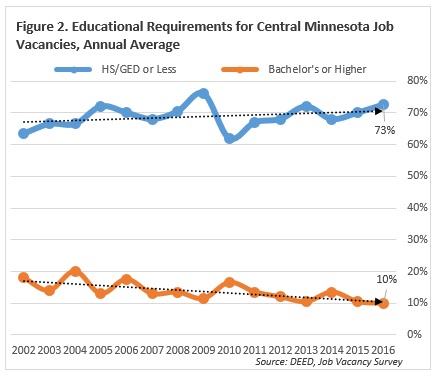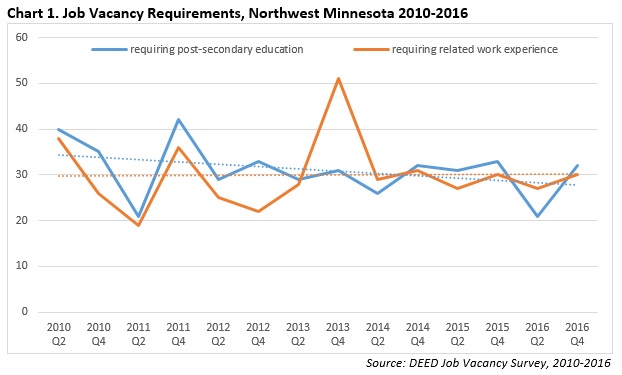Jobs in Minnesota without a four year degree
The Center’s “Great Jobs Without a Four-Year Degree” initiative starts from “a striking disconnect between the educational requirements of the jobs in demand and the educational pursuits of our state’s young people”. As my colleague Kathy Kersten put it recently,
about 49 percent of young Minnesotans enter a four-year college after high school, but only 22 percent of jobs in our state require a bachelor’s degree or more.
Data released this week by the Minnesota Department of Employment and Economic Development bears this out.
the share of job vacancies…requiring higher education has remained mostly constant since at least 2002. If anything, the trend appears to be an increasing share of job openings that require a high school diploma or less, versus a declining share of job vacancies requiring a bachelor’s degree or higher (Figure 2).
In fact, there has been a higher proportion of vacancies requiring a high school diploma or less in the last three years of the survey as compared to the first three, from 2002 to 2004.
In the Northwest Region
While the percentage of vacancies requiring related work experience has mostly stayed the same since 2010, the percentage of vacancies requiring post-secondary education has been declining.
For example, employers hiring for life, physical and social science occupations required a bachelor’s degree or higher less often in 2016 than the year before, seeking applicants with no more than a high school degree much more often. Since the recession, management vacancies have followed the same trend, requiring a bachelor’s degree or higher 31 percent less often today than in 2010. Conversely, employers are now looking for personal care and service workers with an associate degree or vocational training more often in 2016.
Overall, job requirements for both experience and post-secondary education decreased by about 10 percent since 2010, with some variation throughout the years (Chart 1).
In the Southwest Region there is an “outsized influence of health care on the regional economy”. Many of the jobs available include case worker, case aide, case manager, advocate, daily living specialist, clinical assistant, or addictions counselor assistant. There are also social and human service assistants. They “assist in providing client services in a wide variety of fields, such as psychology, rehabilitation, or social work, including support for families,” and “may assist clients in identifying and obtaining available benefits and social and community services”. They also “assist social workers with developing, organizing, and conducting programs to prevent and resolve problems relevant to substance abuse, human relationships, rehabilitation, or dependent care.”
The typical entry-level educational requirement is a high school diploma and short-term on-the-job training, but nearly three-fourths of people working as social and human service assistants in Minnesota have at least some college experience, including 31 percent who have a bachelor’s degree or higher. According to data from the most recent Job Vacancy Survey, just 35 percent of the current openings for social and human service assistants in Southwest Minnesota require post-secondary education, and the median wage offer was $10.00 per hour, showing there may be a misalignment between job seeker expectations and employer needs”
And in the Metro Region’s Scott County
where total county employment grew by an annual average of 3.1 percent in the last five years, Specialty Trade Contractors witnessed 8.2 percent average annual growth. Printing and Related Support Activities saw 9.2 percent average annual growth, Transit and Ground Passenger Transportation 16.0 percent, and Computer and Electronic Product Manufacturing 18.4 percent. Many jobs within these industries offer excellent wages and opportunities for advancement, while not requiring extensive post-secondary education.
John Phelan is an economist at Center of the American Experiment.

